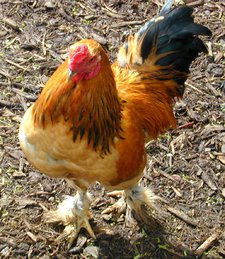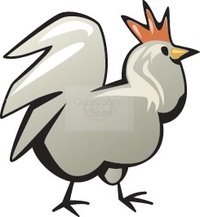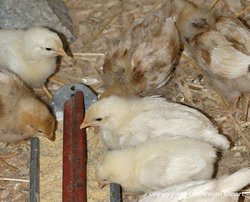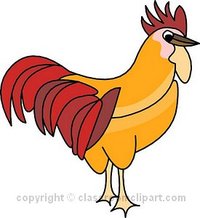Chicken
|
|
| Chickens Conservation status: Secure | ||||||||||||||
|---|---|---|---|---|---|---|---|---|---|---|---|---|---|---|
 A Bantam rooster | ||||||||||||||
| Scientific classification | ||||||||||||||
| ||||||||||||||
| Binomial name | ||||||||||||||
| Gallus gallus (Linnaeus, 1758) |
A chicken (Gallus gallus) is a type of domesticated bird which is usually raised as a type of poultry. It is believed to be descended from the wild Asian Red Junglefowl.
Chickens are the most common bird in the world. The population in 2003 was 24 billion, according to the Firefly Encyclopedia of Birds.
| Contents [hide] |
General biology and habits
Male chickens are known as roosters (US and Canada), cockerals, or cocks. Female chickens are known as hens. Roosters can be differentiated from hens by their striking plumage, marked by long flowing tails and bright pointed feathers on their necks. Both the male and female have distinctive waddles and combs. These organs help to cool the bird by redirecting bloodflow to the skin. In males, the combs are often more prominent, though this is not the case in all varieties.
Chickens are omnivores and will feed on small seeds, herbs and leaves, grubs, insects and even small mammals like mice, if they can get them. Domestic chickens are typically fed commercially prepared feed that includes a protein source as well as grains. Chickens often scratch at the soil to get at adult insects and larva or seed.
Domestic chickens are not capable of flying for long distances, although they are generally capable of flying for short distances such as over fences. Chickens will sometimes fly simply in order to explore their surroundings, but will especially fly in an attempt to flee when they perceive danger. Because of the risk of flight, chickens raised in the open air generally have one of their wings clipped by the breeder — the tips of the longest feathers on one of the wings are cut, resulting in unbalanced flight which the bird cannot sustain for more than a few meters. (more on wing clipping (http://www.omlet.co.uk/chickenguide/guide.php?cat_selected=Chicken%20Care&sub_selected=wing%20clipping))
Chicken eggs vary in color depending on the hen, typically ranging from bright white to shades of brown and even blue or green (Auracana varieties).]] Chickens are gregarious birds and live together as a flock. They have a communial approach to the incubation of eggs and raising of young. Individual chickens in a flock will dominate others, establishing a "pecking order", with dominant individuals having priority for access to food and nesting locations. Removing hens or roosters from a flock causes a temporary disruption to this social order until a new pecking order is established.
Chickens will try to lay in nests that already contain eggs, and have been known to move eggs from neighbouring nests into their own. Some farmers use fake eggs made from plastic or stone to encourage hens to lay in a particular location. The result of this behaviour is that a flock will use only a few preferred locations, rather than having a different nest for every bird.
Hens can also be extremely stubborn when it comes to always laying in the same location. It's not unknown for two (or more) hens to try to share the same nest at the same time. If the nest is small, or one of the hens is particularly determined, this may result in chickens trying to lay on top of each other.
Contrary to popular belief, roosters may crow at anytime of the day. Their crowing - a loud and sometimes shrill call - is a territorial signal to other roosters.
Going broody
Sometimes a hen will stop laying and instead will focus on the incubation of eggs, a state that is commonly known as going broody. A broody chicken will sit fast on the nest, and protest if disturbed or removed, and will rarely leave the nest to eat, drink, or dust bathe. While broody, the hen keeps the eggs at a constant temperature and humidity, as well as turning the eggs regularly.
At the end of the incubation period, the eggs (if fertilised) will hatch, and the broody hen will take care of her young. If the eggs are not fertilised, the hen will eventually grow tired of being broody and leave the nest.
Modern egg-laying breeds rarely go broody, and those that do will often stop part-way through the incubation cycle. Some breeds, such as the Cochin regularly go broody, and make excellent mothers.
Chickens as food
Chickens serve as one of the most common meats in the world, and are frequently prepared as food in a large number of ways. There is significant variation in cooking methods amongst cultures - historically common methods include roasting, baking, and frying. Today, chickens are also cooked by deep frying and prepared as fast food such as chicken nuggets. Modern varieties of chicken - such as the Cornish Cross -- are bred specifically for meat production, with an emphasis placed on the ratio of feed to meat produced by the animal.
Chickens raised specifically for meat are called broilers. In the United States, broilers are typically butchered at a young age. Modern cornish cross hybrids, for example, are butchered as early as 8-weeks for fryers and 12 weeks for roasting birds. Typically, the muscle tissue (breast, legs, thigh, etc), livers, and gizzard are processed for food. Chicken feet are less commonly eaten. The head, internal organs such as the lungs and intestines, and feathers are typically discarded or ground into a protein meal for inclusion in other animal feeds.
Capons (castrated cocks) produce more and fattier meat than normal roosters - for this reason they are considered a delicacy and were particularly popular in the Middle Ages. Caponizing a rooster, unlike castrating a cow or pig, requires delicate surgery and is considered an art almost lost today. The rooster's testicles lie within its body cavity. To remove them requires special equipment and skill. The individual caponizing the rooster must make precise and specialized cuts within the abdomen of the rooster. Infection and potential damage to the bird are possible should an unskilled individual perform the surgery.
Chicken eggs, produced by pullets and laying hens, are also very commonly eaten. The chicken egg is the most commonly eaten bird egg in the world. Hens may lay fertile or infertile eggs. Hens will continue to lay even if a rooster is not present, though these will not be viable. There is no difference in the nutritional value between a fertilized and unfertilized egg. As with meat chickens, modern breeding results in birds that can produce significantly more eggs, focusing on feed to egg conversion ratios. Modern egg chickens are typically derived from the early Leghorn varieties. When the egg is laid, the egg is soft, then hardening into a shell. This protective shell provides a foodsource that is easily transported and stored. Nurtitionally, the egg provides a rich source of protein and vitamins. Recent concerns over cholesterol, however, have caused many to question the inclusion of eggs in the diet.
Some chicken breeds are raised for both meat and egg production. Typically heavy breeds, these are primarily grown by small farmers or hobbyists. These include breeds such as the Wyandotte, Brahma, or Barred Rock.
Chickens as Pets
In Asia, varieties of chickens were developed with striking plumage and were kept for ornamental purposes including feather-footed varieties such as the Cochin or Silkies from China and varieties with extremely long tails from Japan. Asian ornamental varieties were imported into the United States and Great Britain in the late 1800s. Poultry fanciers then began keeping these ornamental birds for exhibition, a practice that continues today. From these origins in Asia, distinctive American varieties of chickens were developed. Today, several cities in the United States still allow residents to keep live chickens as pets though the practice is quickly disappearing. Individuals in rural communities commonly keep chickens for both ornamental and practical value. Some communities ban only roosters, allowing the more quiet hens.
Chickens in Agriculture
In the United States, chickens were once raised primarily on the family farm. Prior to about 1930, chicken was served for primarily on special occasions or on Sunday as the birds were typically more valued for their eggs than meat. Excess roosters or non-productive hens would be culled from the flock first for butchering. As cities developed and markets sprung up across the nation, live chickens from local farms could often be seen for sale in crates outside the market, to be butchered and cleaned onsite by the butcher.
With the advent of refrigeration, poultry production changed dramatically. Large farms and packing plants emerged that could grow birds by the thousands. Adult chickens could be sent to factories for butchering and processing into pre-packaged commercial products to be frozen or shipped fresh to markets or wholesalers. Large farms or factories could be established devoted solely to egg production and packaging. Once a meat consumed only occasionally, the common availability has made chicken a common and significant meat product within developed nations. Growing concerns over cholesterol in the 1980s and 1990s further resulted in increased consumption.
Similarly, egg production also changed with the development of automation and refrigeration. Today, eggs are grown on factory farms in controlled settings. Special varieties of chickens are fed special diets high in calcium and protein to stimulate maximum egg production. Chickens are exposed to artificial light cycles to stimulate egg production year-round. In addition, it is a common practice to force chickens to molt through the careful manipulation of light and the amount of food they receive in order to further increase egg production.
Issues with mass production
Many animal advocates object to killing chickens for food or object to the conditions under the factory farm conditions under which they are raised. Commercial chicken production often involves raising the birds in large crowded warehouses that prevent the chickens from engaging in many of their natural behaviours.
Another welfare issue is the use of genetic selection to create heavy large-breasted birds, which can lead to crippling leg disorders and heart failure for some of the birds. In addition, many scientists have raised concerns that companies growing one variety of bird for eggs are meat are much more susceptible to potentially devastating disease. For this reason, many scientists are promoting the conservation of heritage breeds to retain genetic diversity in the species.
Slaughter is another important welfare issue. Based on USDA figures, it is estimated that millions of chickens are burned alive in scalding tanks every year. Many chickens also suffer broken bones caused by rough handling before and during slaughter. In the United States, chickens are exempt from the Humane Slaughter Act.
In response to these concerns various companies now raise free range birds. Some believe they taste better due to the effects of the exercise and the less stressful environment under which they are raised. Another method, promoted by Joel Salatin, is the use of chicken "tractors". These are portable coops that moved through pastures through the year, allowing the birds to eat herbaceous vegetation and insects without depleting the vegetation at a single spot.
Hatching chickens in Sumatra
The following singular, though effectual mode of hatching chickens, prevails in the interior of Sumatra:
The hens, whether from being frightened off their nests by the rats, which are very numerous and destructive, or from some other cause hitherto prevalent in Sumatra, do not hatch their chickens in the ordinary way, as is seen in almost all other climates. The natives have for this purpose, in each village, several square rooms, the walls of which are made of a kind of brick, dried in the sun. In the middle of these rooms they make a large fire, round which they place their eggs at regular distances. In this manner they let them lie for fourteen days, now and then turning them, that the warmth may be equal in all parts; and on the fifteenth day, the chicken makes its appearance, and proves in every respect as strong as those hatched according to the course of nature.
Chicken diseases
- Avian influenza (bird flu)
- Botulism
- Newcastle disease
- Scaly leg
- Colds
- Coccidiosis
- Marek's disease
- Fowl pox
- Egg bound
- Crop bound
Chickens are also susceptable to parasites, including lice, mites, ticks, fleas, and intestinal Worms.
Chickenpox is a disease of humans, not chickens.
Chickens in religion
In Indonesia the chicken has great significance during the Hindu cremation ceremony. A chicken is a channel for evil spirits which may be present during the ceremony. A chicken is tethered by the leg and kept present at the ceremony for the duration to ensure that any evil spirits present during the ceremony go into the chicken and not the family members present. The chicken is then taken home and returns to its normal life. It is not treated in any special way or slaughtered after the ceremony.
In ancient Greece, the chicken was not normally used for sacrifices, perhaps because it was still considered an exotic animal. Because of its valour, cocks are found as attributes of Ares, Heracles and Athena. The Greeks believed that even lions were afraid of cocks.
In the cult of Mithras, the cock was a symbol of the divine light and a guardian against evil.
In the Bible, Jesus prophesied the betrayal by Peter: "And he said, I tell thee, Peter, the cock shall not crow this day, before that thou shalt thrice deny that thou knowest me." (Luke 22:43) Thus it happened (Luke 22:61), and Peter cried bitterly. This made the cock a symbol for both vigilance and betrayal.
Earlier, Jesus compares himself to a mother hen: "How often would I have gathered thy children together, even as a hen gathereth her chickens under her wings, and ye would not!" (Matthew 23:37; also Luke 13:34).
In many Central European folk tales, the devil is believed to flee at the first crowing of a cock.
History
The first pictures of chickens in Europe are found on Corinthian pottery of the 7th century BC. The poet Cratinus (mid-5th century BC, according to the later Greek author Athenaeus) calls the chicken "the Persian alarm". In Aristophanes's comedy The Birds (414 BC) a chicken is called "the Median bird", which points to an introduction from the East. Pictures of chickens are found on Greek red figure and black-figure pottery.
In ancient Greece, chickens were still rare and were a rather prestigious food for symposia. Delos seems to have been a centre of chicken breeding.
An early domestication of chickens in New Guinea is probable, since the word for domestic chicken (*manuk) is part of the reconstructed Proto-Austronesian language (see Austronesian languages). Chickens, together with dogs and pigs, were the domestic animals of the Lapita culture, the first Neolithic culture of Oceania.
Chickens were spread by Polynesian seafarers and reached Easter Island in the 12th century AD, where they were the only domestic animal, with the possible exception of the Polynesian Rat (Rattus exulans). They were housed in extremely solid chicken coops built from stone. Traveling as cargo on trading boats, they reached the Asian continent via the islands of Indonesia and from there spread west to Europe and western Asia.
Chickens in Ancient Rome
The Romans used chickens for oracles, both when flying ("ex avibus") and when feeding ("auspicium ex tripudiis"). The hen ("gallina") gave a favourable omen ("auspicium ratum"), when appearing from the left (Cic.,de Div. ii.26), like the crow and the owl.
For the oracle "ex tripudiis" according to Cicero (Cic. de Div. ii.34), any bird could be used, but normally only chickens ("pulli") were consulted. The chickens were cared for by the pullarius, who opened their cage and fed them pulses or a special kind of soft cake when an augury was needed. If the chickens stayed in their cage, made noises ("occinerent"), beat their wings or flew away, the omen was bad; if they ate greedily, the omen was good.
In 249 BC, the Roman general Publius Claudius Pulcher had his chickens thrown overboard when they refused to feed before the battle of Drepana, saying "If they won't eat, perhaps they will drink." He promptly lost the battle against the Carthaginians and 93 Roman ships were sunk. Back in Rome, he was tried for impiety and heavily fined.
In 161 BC a law was passed in Rome that forbade the consumption of fattened chickens. It was renewed a number of times, but does not seem to have been successful. Fattening chickens with bread soaked in milk was thought to give especially delicious results. The Roman gourmet Apicius offers 17 recipes for chicken, mainly boiled chicken with a sauce. All parts of the animal are used: the recipes include the stomach, liver, testicles and even the pygostyle (the fatty "tail" of the chicken where the tail feathers attach).
The Roman author Columella gives advice on chicken breeding in his 8th book of his treatise on agriculture. He identifies Tanagrian, Rhodic, Chalkidic and Median (commonly misidentified as Melian) breeds, which have an impressive appearance, a quarrelsome nature and were used for cockfighting by the Greeks. For farming, native (Roman) chickens are to be preferred, or a cross between native hens and Greek cocks. Dwarf chickens are nice to watch because of their size but have no other advantages.
Per Columella, the ideal flock consists of 200 birds, which can be supervised by one person if someone is watching for stray animals. White chickens should be avoided as they are not very fertile and are easily caught by eagles or goshawks. One cock should be kept for five hens. In the case of Rhodian and Median cocks that are very heavy and therefore not much inclined to sex, only three hens are kept per cock. The hens of heavy fowls are not much inclined to brood; therefore their eggs are best hatched by normal hens. A hen can hatch no more than 15-23 eggs, depending on the time of year, and supervise no more than 30 hatchlings. Eggs that are long and pointed give more male, rounded eggs mainly female hatchlings.
Per Columella, Chicken coops should face southeast and lie adjacent to the kitchen, as smoke is beneficial for the animals. Coops should consist of three rooms and possess a hearth. Dry dust or ash should be provided for dust-baths.
According to Columella, chicken should be fed on barley groats, small chick-peas, millet and wheat bran, if they are cheap. Wheat itself should be avoided, it is harmful to the birds. Boiled ryegrass (Lollium sp.) and the leaves and seeds of alfalfa (Medicago sativa L.) can be used as well. Grape marc can be used, but only when the hens stop laying eggs, that is, about the middle of November; otherwise eggs are small and few. When feeding grape marc, it should be supplemented with some bran. Hens start to lay eggs after the winter solstice, in warm places around the first of January, in colder areas in the middle of February. Parboiled barley increases their fertility; this should be mixed with alfalfa leaves and seeds, or vetches or millet if alfalfa is not at hand. Free-ranging chickens should receive two cups of barley daily.
Columella advises farmers to slaughter hens that are older than three years, because they no longer produce sufficient eggs. Capons were produced by burning out their spurs with a hot iron. The wound was treated with potter's chalk.
For the use of poultry and eggs in the kitchens of ancient Rome see Roman eating and drinking.



